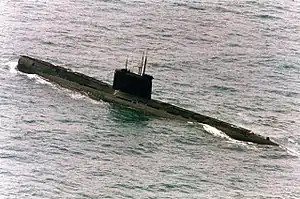Tango-class submarine
The Tango class was the NATO reporting name of a class of diesel-electric submarines that were built in the Soviet Union to replace the Foxtrot-class submarines assigned to the Black Sea and Northern Fleets. The Soviet designation of this class was Project 641B and it was also known as the Som (Catfish) class. The first of the class was completed in 1972 at Gorky. A total of 18 were built in two slightly different versions. The later type was several metres longer than the first, possibly because of the installation of ASW missile equipment.
 A Tango-class submarine in the North Atlantic. | |
| Class overview | |
|---|---|
| Name: | Tango class (Project 641B) |
| Builders: | Gorky |
| Operators: |
|
| Preceded by: | Foxtrot class |
| Succeeded by: | Kilo class |
| Completed: | 18 |
| Active: | 0 |
| Retired: | 15 |
| Preserved: | 3 |
| General characteristics | |
| Type: | Submarine |
| Displacement: |
|
| Length: | 91 m (298 ft 7 in) |
| Beam: | 9.1 m (29 ft 10 in) |
| Draught: | 7.2 m (23 ft 7 in) |
| Propulsion: |
|
| Speed: |
|
| Complement: | 62 men (12 officers) |
| Armament: |
|
- For the pre-1914 submarines also known as the Som class in Russia, see Som-class submarine.
The bow sonar installations appear to be similar to those fitted to Soviet nuclear attack submarines. The propulsion plant was the same as the last subgroup of the Foxtrot class. The Tango class had far more battery capacity, far higher than any previous conventional submarine class in the Soviet Navy; as a result, pressure hull volume increased. This allowed an underwater endurance in excess of a week before snorkeling was required.
Coupled with new armament and sensor fit, the Tango class were ideal for ambush operations against Western nuclear submarines at natural chokepoints.
Because of its all-hull rubber coating, the sub class was nicknamed "rezinka" [rubber]
Construction of this class has now stopped. One unit remains in the Black Sea Fleet but it may have been decommissioned since 2010.
Museum ships
 Schematic of the Tango class
Schematic of the Tango class B-307, Togliatti
B-307, Togliatti B-396, Moscow
B-396, Moscow B-515, Hamburg
B-515, Hamburg Tango B-396 torpedo room
Tango B-396 torpedo room
Three 641B-class submarines operate as museum ships:
- B-307, fully raised on ground - Togliatti Museum of Technology, Samara, Russia
- B-396, afloat in Tushino reservoir - Moscow Navy Museum
- B-515, afloat in Baakenhafen in Hamburg - museum in Hamburg
The conning towers of stricken B-319' and B-474 are on display in Polyarny and Ryazan.
B-380 had been in layup in Sevastopol Harbor awaiting either refit or scrapping as of 2008, but during the night of December 14–15, 2019 the floating dock PD-16, which contained B380, sunk. B-380 capsized to port and partially sank, and by Dec 19 it was still unclear whether the submarine was afloat or resting on the bottom. By 11th May 2020 B-380 was 70% scrapped.
References
- The Encyclopedia Of Warships From World War Two To The Present Day, General Editor Robert Jackson.
External links
| Wikimedia Commons has media related to Tango-class submarines. |
- RussianWarrior page about the Tango Class
- Russian Tango Class Submarines - Complete Ship List (English)